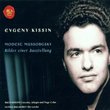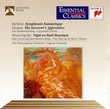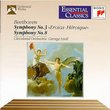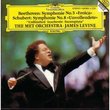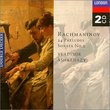| All Artists: Robert Schumann, Leonard Bernstein, Vienna Philharmonic Orchestra Title: Schumann: The 4 Symphonies Members Wishing: 1 Total Copies: 0 Label: Deutsche Grammophon Release Date: 2/11/1997 Genre: Classical Styles: Historical Periods, Romantic (c.1820-1910), Symphonies Number of Discs: 2 SwapaCD Credits: 2 UPC: 028945304922 |
Search - Robert Schumann, Leonard Bernstein, Vienna Philharmonic Orchestra :: Schumann: The 4 Symphonies
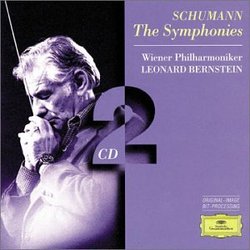 | Robert Schumann, Leonard Bernstein, Vienna Philharmonic Orchestra Schumann: The 4 Symphonies Genre: Classical
Leonard Bernstein was full of surprises. A conductor often accused of hopeless self-indulgence, he responded intuitively to the classical aesthetic of Haydn, and no less to the early Romantic bravado of Schumann. In fact... more » |
Larger Image |
CD DetailsSynopsis
Amazon.com essential recording Leonard Bernstein was full of surprises. A conductor often accused of hopeless self-indulgence, he responded intuitively to the classical aesthetic of Haydn, and no less to the early Romantic bravado of Schumann. In fact, these symphonies have never been better played or conducted than they are here. These are performances of high passion--they're either very fast or very slow--and extraordinary color and drama. Bernstein sticks faithfully to the composer's original, thick orchestrations but makes each symphony work through playing of unflagging clarity and chamber music-like balance. That this was all done live, in performances of such wide emotional range, is amazing. But amazing was what Bernstein did best. --David Hurwitz Similar CDsSimilarly Requested CDs
|
CD ReviewsSome of the maestro's best work Larry VanDeSande | Mason, Michigan United States | 06/01/2004 (5 out of 5 stars) "I live in a part of America where the PBS classical programming director loves the Schumann symphonies and schedules a different recording 2-3 days a week while I listen via Internet stream. They are so ridiculously overscheduled a coworker and I send e-mails to each other announcing the obligatory "Schumann hour" has commenced for the day, in case one of us should miss it. Ergo, I have heard most of the famous and infamous versions of the Schumann symphonies, including a couple of Lenny's New York recordings. I don't think Schumann was a great symphonist (he certainly was not a great orchestrator) and I don't believe, all things considered, that his four symphonies stand up to the quad of Brahms, the Mendelssohn five, Tchaikovsky's half-dozen, the nine of Beethoven, Mahler and Bruckner, the 15 of Shostakovich, or even the 3 from Rachmaninoff. Well, maybe they're better than Rachmaninoff. But you'd never know there were any limitations by listening to these glorious CDs from Bernstein and the Vienna Philharmonic, whose concertmaster said the 1984-85 collaboration resulted in some of the most memorable recording sessions of his lifetime (all "live" by the way...meaning not dead?) It is easy to hear that enthusiasm on these CDs. Bernstein, who could be too loud, too fast, too indulgent and just about too everything except timid, seems to me more perfectly mated to Schumann's manic-depression than just about any conductor in history. For once, Lenny's overindulgence seems perfectly at home...when it comes in the beginning of the "Rhenish"...or in the return of the first movement's big subject in "Spring"...or the drama of the Fourth Symphony's concluding Lebhaft. I thought Lenny got everything just right in these recordings. He played up the schmaltz each time it was nearby and it always sounds wonderful, evocative and appropriate. That's something I could almost never say in his other Vienna recordings, which have been reissued by DG. His Beethoven symphonies, in particular, were in my view regularly marred by exaggeration, ill tempo or inappropriate tenuto. But those gooey effects seem to enhance the drama and schizophrenia of the Schumann symphonies. I don't know another conductor who could do such a sympathetic job with the symphonies of Robert Schumann." Beyond Belief Charles Emmett | Oroville, California (the boonies) | 07/08/2003 (5 out of 5 stars) "I have grown up with Maestro Bernstein. When I was young there was fire in all of the performances that I owned. Bernstein and Ormandy were at the top of the list when it came to fiery and great orchestral performances. I had his Beethoven cycle, several of the Mahler symphonies both with Mestroes Bernstein and Ormandy.When I lost my first collection,to a fire,I did not buy recordings for some time. But, when I did, I went back to my old Ormandy favorites and started purchasing Muti PHO recordings and started to learn to listen to the more expres-sive and refined recordings. They were as maginificently played, as before, but I had grown and my listening powers had grown to appreciate phrasing and nuance and deeper emotional conducting. I had learned to tell the difference between the 'warhorse' style and the 'expressive' style.I must say that this is the most beautiful, introspective conducting I might have ever heard. I say buy this set for the adagio of the 2nd symphony alone. Tears were streaming down my face at the end of it. The soaring of the strings in the final moments, I was sobbing! I don't know how the Maestro was able to conduct the finale, it was a live performance after all, although the time between movements was not on the recording itself. Musicians and conductor had to take a really deep breath after that because it was absolutely breathtaking! Then the finale was so positive so enlightening. I must say I have never heard a finer performance.I used to have the old recordings of the first and fourth by the Maestro and also the Szell recordings, which were considered the standard, especially the second. These were not the deeply expressive performances we have here. I will say greatly performed, but 'warhorse'type performances. Again, the instrospection and how Maestro Bernstein brings the virtuosity of the orchestra and the refinement of the strings. Yes there is fire when it is needed, but the refinement, the change of tempo, the nuance of every phase. Did Ricardo Muti study with him?I don't know about you, but the audience noise does not bother me because recorded perfomances are usually much more intense and incredibly better in front of an audience. Isn't that what a performer dreams of doing anyway? Isn't that the life of a performer to give his/her all infront of a live audience?Well, there is no disappointment here because the guts of every performer, including the Maestro, are laid out on the stage for all to feel and hear.My highest recommendation!" Lenny found Mahler in Schumann! Thomas Martin | USA | 10/24/2006 (5 out of 5 stars) "I own the Szell recordings which finally convinced me that Schumann's symphonies were worth getting to know (Kubelik's readings on Sony just didn't do a thing for me), but listening to Bernstein's Schumann was like hearing an entirely different composer. I agree with another reviewer who wrote about his response to the Adagio in Symphony #2. Although I didn't have tears rolling down my face, it certainly grabbed me and wouldn't let go (Szell clocks-in at a little over 11 minutes; Bernstein over 13 - but its not overt indulgence like his Tchaikovsky 6th). It was like listening to Lenny's Concertgebouw Mahler 9th. It is wrenching. I wouldn't ever let go of Szell or Bernstein - both have much to say about this often maligned composer of symhonies."
|

 Track Listings (8) - Disc #1
Track Listings (8) - Disc #1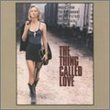

![Brahms: 21 Ungarische Tanze [21 Hungarian Dances / 21 Danses Hongroises]](https://nationalbookswap.com/cd//m/94/0094/6020094.jpg)


